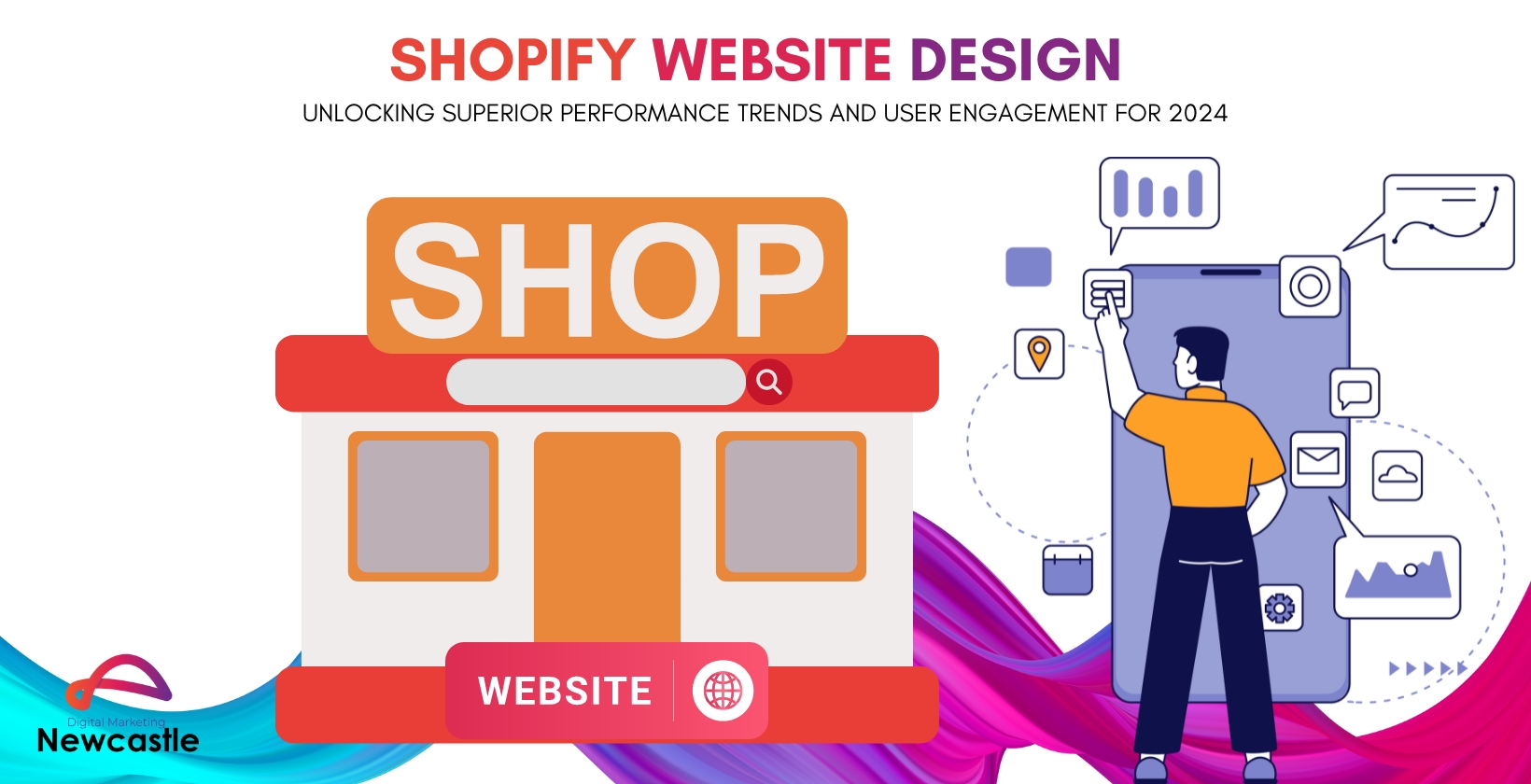Looking to take your online store to the next level in 2024? Consider Shopify website design.
Discover why Shopify’s website design is important, the benefits it offers, and the key features of a successful design.
Stay ahead with the latest trends and learn how to improve user engagement, optimise performance through mobile responsiveness, and utilise analytics effectively.
Follow SEO best practices, avoid common design mistakes, integrate social media, and enhance functionality with Shopify apps.
Understand the importance of custom branding and why choosing us for your Shopify design needs will help you create the perfect online store.
Uncover key takeaways and next steps to elevate your Shopify website design, including user-friendly navigation, high-quality visuals, and strong branding.
What Is Shopify Website Design?
Shopify website design involves creating and customising an online store using Shopify’s eCommerce platform. This platform provides various tools to help businesses build visually appealing and functional websites.
A well-created Shopify website is essential for online businesses. It offers a user-friendly interface that enables customers to browse products and make purchases effortlessly.
This platform supports many businesses, from small startups to well-established brands, enabling them to establish an online presence and connect with a global audience.
With its intuitive drag-and-drop interface and a wide selection of customizable themes, Shopify helps businesses effectively showcase their products and build a distinct brand identity.
Shopify is more than just a website builder. It’s a comprehensive solution that includes secure payment gateways, inventory management tools, and SEO optimization, all in one place.
Why Is Shopify Website Design Important?
Creating a Shopify website is vital for businesses aiming to establish a strong online presence, improve customer experience, and access essential marketing tools for optimising their online stores.
Effective Shopify design attracts and retains customers with intuitive navigation, appealing layouts, and seamless functionality, enhancing engagement and satisfaction.
This results in higher conversion rates and increased sales. Also, a well-designed Shopify website is key to Search Engine Optimization (SEO), improving visibility and ranking on search engine results pages. By leveraging Shopify, businesses can unlock numerous advantages that make it a preferred choice for website design.
What Are the Benefits of Using Shopify for Website Design?
Shopify offers various benefits for website design, such as scalability with Shopify Plus, exceptional support services, and the ability to stay current with the latest e-commerce trends, especially in the UK market.
Considering these advantages, it’s important to consider what makes a Shopify website truly effective and user-friendly.
What Are the Key Elements of a Successful Shopify Website Design?
A successful Shopify website design incorporates several key elements that ensure a seamless user experience, including intuitive navigation, responsive design, and high-quality visuals.
User-Friendly Navigation
User-friendly navigation on a Shopify website is essential for enhancing the overall user experience and ensuring visitors can easily find what they want.
An intuitive navigation system seamlessly guides users through the website, which is vital for increasing customer engagement and driving conversions.
When designing menus and navigation structures, keep them simple and well-organised. Utilise clear labels and categories to help visitors navigate effortlessly.
Consider implementing dropdown menus or breadcrumbs to access different site sections easily. Testing your navigation across different devices and browsers can also ensure a consistent user experience.
Responsive Design
Responsive design is critical for any Shopify website, as it ensures that the site is accessible and user-friendly across all devices, including mobile phones and tablets.
A responsive design enhances the overall user experience. It is important in improving a website’s search engine optimization (SEO) performance. Search engines like Google prioritise responsive websites in their rankings, increasing visibility and traffic. By implementing responsive design techniques, such as fluid grids, flexible images, and media queries, Shopify websites can adapt seamlessly to different screen sizes and resolutions.
High-Quality Visuals
High-quality visuals are a fundamental aspect of effective Shopify website design. They capture visitors’ attention and enhance the site’s overall aesthetic appeal.
When selecting images and graphics for a website, it is important to ensure they align with the brand’s identity and messaging. Consistency in visual elements helps reinforce the brand image and build trust with viewers.
Opt for images that convey the brand’s desired emotions and values to establish a strong connection with the target audience. Pay attention to the resolution and clarity of the visuals to maintain a professional look across the site. Engaging visuals can significantly improve user engagement by creating a more enjoyable browsing experience.
Strong Branding
Strong branding on a Shopify website is essential for creating a coherent online presence and establishing customer trust and recognition.
When a website showcases a consistent brand identity, it helps customers easily identify and connect with the business.
The logo, colour schemes, and tone of voice all play a vital role in conveying the brand’s values and message. Implementing these elements cohesively in a Shopify design can enhance the overall user experience and make the brand more memorable.
Designing a visually appealing website with a clear brand message attracts customers and encourages repeat visits, leading to higher engagement and conversion rates.
Clear Call-to-Actions
Clear calls-to-action (CTAs) on a Shopify website are essential for guiding visitors to take desired actions and increasing conversions. Effective CTAs should be visually appealing and strategically placed to catch visitors’ attention.
Positioning CTAs above the fold or at critical points throughout the webpage can greatly boost their visibility and engagement. Using action-oriented language like ‘Sign Up Now’ or ‘Shop the Sale’ encourages users to act.
A well-designed CTA stands out from other content through contrasting colours or bold typography. Regularly testing and optimising CTAs based on user behaviour can enhance their effectiveness. Enhancing these aspects will set a strong foundation for increasing user interaction and keeping visitors engaged.
How Can You Improve User Engagement on Your Shopify Website?
Improving user engagement on your Shopify website involves providing high-quality content, using social media to connect, and offering personalised recommendations to create a more interactive and satisfying experience for visitors.
Provide High-Quality Content
Providing high-quality content on your Shopify website enhances customer experience and keeps visitors engaged.
Creating engaging blog posts, informative product descriptions, and captivating multimedia content can set your e-commerce site apart.
It is essential to understand your target audience and customise your content to meet their needs and preferences. Audience research can uncover valuable insights that will help you create content that resonates with your customers.
Consistency is key in content creation. Establish a content calendar to ensure a steady flow of high-quality content across various platforms. By planning ahead and staying organised, you can maintain a strong connection with your audience.
Utilise Social Media
Utilising social media platforms like Facebook, Instagram, Pinterest, and TikTok can greatly enhance user engagement on your Shopify website by driving traffic and fostering community interaction.
Integrating social media with your Shopify store opens up many opportunities to reach a wider audience base. Each platform offers unique features that can be utilised strategically to showcase your products, interact with customers, and build brand loyalty.
For instance, you can create visually appealing posts and stories on Instagram to showcase your products.
Facebook allows you to run targeted ads and create a community through groups. Pinterest is ideal for driving traffic through visually engaging pins.
TikTok offers a fun way to showcase your products through short videos.
Offer Personalised Recommendations
Offering personalised recommendations on your Shopify website using AI and machine learning can greatly improve the customer experience by providing relevant product suggestions.
Personalisation plays an important role in user engagement, creating a more customised experience for each individual. Technology can analyse user behaviour, preferences, and past interactions by utilising AI and machine learning algorithms to deliver personalised recommendations in real time. This boosts customer satisfaction and increases the likelihood of conversion and repeat purchases.
Use Customer Reviews and Testimonials
Using customer reviews and testimonials on your Shopify website effectively builds trust and credibility, encouraging new visitors to make purchases.
When potential customers see positive feedback from others, they are more likely to feel confident in your products or services. This social proof is a powerful endorsement that can influence their buying decision.
It is essential to make these reviews easily accessible on your site, preferably on the homepage or product pages, so visitors can easily find them.
Displaying star ratings or excerpts from reviews can also capture attention and highlight the best features of your offerings. Including a mix of testimonials, ratings, and detailed reviews provides a comprehensive overview of customer satisfaction.
Implement Live Chat Support
Adding live chat support to your Shopify website can greatly boost user engagement by providing immediate assistance and fostering positive customer interactions.
This feature allows businesses to communicate in real time with visitors, enabling quick resolution of issues and opening up more sales opportunities.
Customers benefit from the convenience of instant support, avoiding the need for phone calls or waiting for email responses. Setting up live chat is straightforward, with many e-commerce platforms like Shopify offering easy integration with popular chat tools.
It’s important to make the chat widget accessible on all pages to encourage user engagement. Training your support team to handle inquiries efficiently and courteously is key to providing a seamless customer experience.
Incorporating such features is just one aspect of optimising your Shopify website. Staying updated with current design trends ensures your site remains competitive and visually appealing. This brings us to consider the latest trends in Shopify website design.
What Are the Latest Trends in Shopify Website Design?
Current trends in Shopify website design focus on AI-driven personalisation, minimalist aesthetics, and improved mobile responsiveness.
AI and machine learning are changing online retail by allowing businesses to analyse customer data and offer customised experiences. The minimalist design trend also makes waves, providing a clean, streamlined look that enhances the user experience by emphasising simplicity and key elements.
This shift towards minimalism improves visual appeal and plays a vital role in enhancing mobile performance. Understanding the impact of mobile responsiveness on Shopify sites can reveal how these design choices improve overall functionality and user satisfaction.
How Does Mobile Responsiveness Affect Shopify Performance?
Mobile responsiveness is key to Shopify’s performance, ensuring a seamless user experience across devices and retaining visitors while boosting engagement.
A responsive Shopify site adapts to various screen sizes and resolutions, facilitating easy navigation, content reading, and transaction completion. This enhances the user experience, leading to higher conversion and lower bounce rates.
From an SEO standpoint, Google prioritises mobile-friendly sites in search results, positively impacting your site’s visibility and ranking. To optimise your Shopify site for mobile devices, focus on streamlined design, fast loading times, clear calls-to-action, and straightforward checkout processes.
To further enhance your Shopify site’s capabilities, consider exploring additional tools and integrations to enhance website functionality and user experience.
What Shopify Apps Enhance Website Functionality and User Experience?
Shopify offers a wide array of apps designed to enhance both website functionality and user experience. These tools cater to various business needs, from SEO optimization tools like SEO Image Optimiser that boost search engine rankings to customer engagement apps such as Reamaze for live chat and help desk support.
Targeted marketing efforts can be amplified with Mailchimp for personalised email campaigns. Improving website design and user interaction is easy with apps like Loox for customer reviews and Product Options by Bold for customizable product selections.
Businesses can streamline operations and effectively drive conversions by integrating the right mix of these apps. To make the most of these tools, it’s important to understand how data-driven insights can influence your store design for even better results.
How to Use Analytics to Optimise Your Shopify Store Design?
Using analytics to optimise your Shopify store design is key to understanding website traffic, visitor behaviour, and conversion rates, which in turn inform data-driven improvements.
Tools like Google Analytics provide valuable insights that shape the strategic direction of your online store. By identifying patterns and trends in user interactions, you can pinpoint the most visited pages, understand where visitors drop off, and determine what actions lead to conversions.
This knowledge enables you to make informed decisions that align with your business goals. With this foundation, it’s essential to consider additional strategies to boost your store’s visibility and effectiveness.
What SEO Best Practices Should Shopify Store Owners Follow?
SEO best practices for Shopify shop owners include optimising product descriptions, improving site speed, and obtaining backlinks to increase website traffic and enhance search engine rankings.
Incorporating relevant keywords naturally into product descriptions and writing compelling copy can attract potential customers. Descriptive filenames and alt text for images also contribute to better SEO.
Site speed is vital for user experience and search engine rankings. Shopify shop owners should compress images, use browser caching, and minimise unnecessary code.
Backlinks from reputable websites can boost domain authority and credibility, improving organic search visibility and driving more targeted traffic to the online shop.
Another important aspect that can elevate a Shopify store’s performance involves its visual and thematic identity, making it imperative to consider the role of custom branding.
How Important Is Custom Branding in Shopify Design?
Creating a custom brand for your Shopify store is essential to making your business stand out and leaving a lasting impression on your audience. Custom branding involves creating a compelling narrative that distinguishes your store from competitors.
Start by defining your brand values and messaging to ensure they are consistently reflected across all customer interactions. Use colours, fonts, and imagery that align with your brand personality and appeal to your target market.
Integrate these elements throughout your Shopify store design, from the logo to the product pages, to build a cohesive and memorable brand experience. A strong brand identity fosters customer trust and loyalty, greatly enhancing your business’s success.
While focusing on custom branding, it’s also important to be aware of potential design pitfalls that could undermine your efforts and affect your store’s performance.
What Common Design Mistakes Should Shopify Store Owners Avoid?
Shopify store owners should avoid common design mistakes, such as cluttered layouts, poor navigation, and neglecting mobile optimization, which can harm user experience.
A cluttered layout overwhelms visitors and makes it hard to find what they need. Similarly, poor navigation frustrates users, leading to high bounce rates and lower conversion rates.
Mobile optimization is vital because many people shop on smartphones and tablets, and ignoring this can result in lost sales and unhappy customers. Enhancing user experience also includes seamlessly integrating social media into your Shopify website.
How to Integrate Social Media into Your Shopify Website?
Integrating social media into your Shopify website is key to boosting engagement and driving traffic from platforms like Facebook, Instagram, Pinterest, and TikTok.
Start by displaying easily accessible social media icons on your Shopify store, enabling visitors to connect with your brand effortlessly. Syncing your social media accounts with your Shopify store helps you reach a broader audience and foster a loyal customer base.
Looking to enhance your store even further? We have compelling reasons why we’re the ideal choice for your Shopify design needs and how we can help you create the perfect online store.
Why Choose Us for Your Shopify Design Needs: How Can We Help You Create the Perfect Online Store?
Choosing us for your Shopify design needs means receiving expert customization and dedicated support, ensuring your business has the ideal online store aligned with your strategy.
Our professional agency leverages extensive experience and industry insights to enhance your e-commerce presence using best practices. With advanced customization options, your store will attractively distinguish itself from competitors, showcasing your brand.
Our support services provide a dedicated team to handle technical issues or updates, allowing you to concentrate on business growth. To fully maximise these benefits, reflecting on key takeaways and considering the next steps for enhancing your Shopify website design is important.
Key Takeaways and Next Steps for Elevating Your Shopify Website Design
Wrapping up, it’s essential to focus on optimisation, user experience, and strategic design features to elevate your Shopify website and drive conversions.
Incorporating SEO best practices, ensuring fast loading speeds, and implementing clear call-to-action buttons are important for enhancing optimization on your Shopify platform.
Prioritising a seamless navigation flow, mobile responsiveness, and visually appealing layouts will greatly improve visitors’ overall user experience.
Strategic design features such as high-quality imagery, consistent branding, and intuitive product categorisation can influence customer perception and boost conversions.
You can create a dynamic and competitive online storefront that aligns with your business goals by consistently monitoring analytics, gathering user feedback, and iteratively refining your website design.





